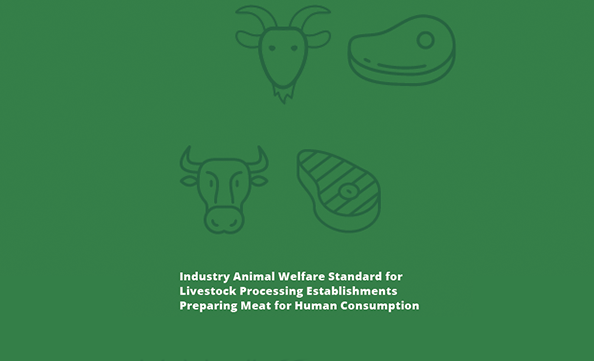The Standards
‘Industry Animal Welfare Standards for
In 2005 AMIC and AMPC Animal Welfare Committee was established. It comprises of representatives from state and federal governments, the scientific community, animal welfare organisations, RSPCA and Animals Australia, as well as technical experts and Industry representatives. This Committee is responsible for reviewing the Standards to ensure they continue to be best practice.
The Standards help fulfil the expectations of both the Australian meat processing industry and the community of high levels of animal welfare management at Australian livestock processing establishments.
The Standards include the provisions of Australia’s current minimum regulated animal welfare standards at processing and also international and commercial requirements.
Specifically The Standards provide a ‘one-stop-shop’ for meeting animal welfare requirements.
Industry Animal Welfare Standards – Fourth Edition
To view the full Standards and Guidance publications, click on the buttons below.
Meet Existing Standards
Developed to meet existing Australian mandatory animal welfare requirements, OIE and published commercial guidelines.
Maintaining Standards
The AMIC/AMPC Animal Welfare Standard Review Committee maintains the content of the Standards.
Industry Commitment
65% of processing establishments across Australia are currently certified, covering approximately 80% of Australia’s red meat production.
Clear Guide Lines
Provides clear guidelines on how to comply and how to assess compliance with the industry best practice standards.
Comprehensive Review
A comprehensive review is conducted to ensure the Standards remain current and best practice.
Ongoing Training
Auditors are required to participate in ongoing, comprehensive training and re-certification on an annual basis.
Summary of Standards

Management Procedures & Planning
Standard Operating Procedures for the management of livestock are developed, implemented and include contingency procedures to prevent and mitigate possible risks to animal welfare.

Design & Maintenance of Facilities and Equipment
Facilities and equipment are designed and maintained to ensure minimal interference or stress is incurred by livestock.

Staff Competency
All personnel responsible for the handling of livestock are competent in their tasks consistent with the requirements of these Standard

Management and Humane Destruction of Weak, Ill or Injured Livestock
Weak, ill or injured livestock are identified and promptly treated in a humane manner.

Management of Livestock to Minimise Stress and Injuries
Livestock are routinely managed to minimise stress and injuries.

Humane Slaughter Procedures
Restraint, stunning and slaughter procedures are carried out in a humane and effective manner.
Standards Documentation
Australian Standards and Guidelines
The Australian Standards and Guidelines for the Welfare of Animals, where these apply to the livestock processing industry. Australian Standards and Guidelines for the Welfare of Animals as endorsed by the Primary Industry Ministerial Council replace the existing and relevant Codes of Practice for the Welfare of Animals.
AS 4696-2007
AS 4696-2007 Australian Standard for the Hygienic Production and Transportation of Meat and Meat Products for Human Consumption.
WOAH Terrestrial Animal Health Code (2024)
WOAH Terrestrial Animal Health Code (2024)
The WOAH Terrestrial Animal Health Code (2024): Guidelines for the welfare of animals during slaughter. World Organisation for Animal Health (WOAH).
Commerical Guidelines
Published commercial guidelines, for example the American Meat Institute Foundation’s Good Management Practices for Animal Handling and Stunning, 2005 Edition.
Model Code of Practice
The Model Code of Practice for the Welfare of Animals at Livestock Slaughtering Establishments. SCARM Report 79.
